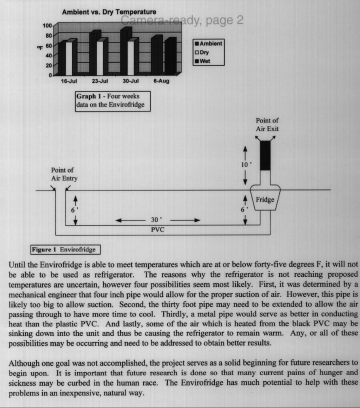Paul R. Neil and Dr. Richard Terry, Agronomy and Horticulture
This research project was designed (see Figure 1) and experimented with in hopes of eventually assisting people of third-world countries to refrigerate and store food and medicine for extended periods of time, much the same as conventional refrigeration. Overall, designing and performing this project has helped to increase my confidence in being able to perform creative research and has shown me the need which exists for increased environmental engineering to solve worldwide needs. I feel the Envirofridge project has been a success, especially in light of it being the first refrigerator of its kind.
The Envirofridge differs from conventional refrigerators because it is run purely by the energy available in the natural environment. Primarily, the Envirofridge runs on thermal radiation, and evaporative and sensible cooling (which sensible cooling occurs when there is a change in temperature without any change in humidity). This refrigerator did not require any conventional energy because many third world countries where this unit may eventually be used do not have the convenience of electricity. Hence, real life situations were synthesized as much as possible from electricity availability to material availability in a third-world setting.
The following four goals were proposed in performing this research: 1) To construct a self sustaining (or very low maintenance) refrigeration unit which used no energy other than that of convection and the cooling properties of the earth and water, 2) To construct the unit for a hundred dollars or less in materials, 3) To run variable tests until the unit could be held fifty-five degrees Fahrenheit and under, constantly, and 4) To prove that the passively cooled refrigerator could be built and maintained.
The refrigerator was built and placed into the ground on July 9, 1996 and temperature data was taken each Tuesday thereafter for four weeks consecutively, beginning on July 16, 1996. The first three weeks of data measured temperatures which were the result of thermal energy and sensible cooling only, termed “Dry” data. At the end of the third week water was added to the experiment in order to see the effects of evaporation on cooling in addition to thermal energy and sensible cooling. This last week’s data was termed “Wet” data. All data was taken during the evening hours, and ambient air temperatures were also taken at that time in order to compare the possible effects of outside air temperatures to the refrigerator . See Graph 1 for “ Dry”, “Wet”, and “Ambient” temperatures.
In sum, all four goals were met except goal number three. The Envirofridge reached seventy degrees F at the second week and remained there for the remainder of the experiment.
Until the Envirofridge is able to meet temperatures which are at or below forty-five degrees F, it will not be able to be used as refrigerator. The reasons why the refrigerator is not reaching proposed temperatures are uncertain, however four possibilities seem most likely. First, it was determined by a mechanical engineer that four inch pipe would allow for the proper suction of air. However, this pipe is likely too big to allow suction. Second, the thirty foot pipe may need to be extended to allow the air passing through to have more time to cool. Thirdly, a metal pipe would serve as better in conducting heat than the plastic PVC. And lastly, some of the air which is heated from the black PVC may be sinking down into the unit and thus be causing the refrigerator to remain warm. Any, or all of these possibilities may be occurring and need to be addressed to obtain better results.
Although one goal was not accomplished, the project serves as a solid beginning for future researchers to begin upon. It is important that future research is done so that many current pains of hunger and sickness may be curbed in the human race. The Envirofridge has much potential to help with these problems in an inexpensive, natural way.

